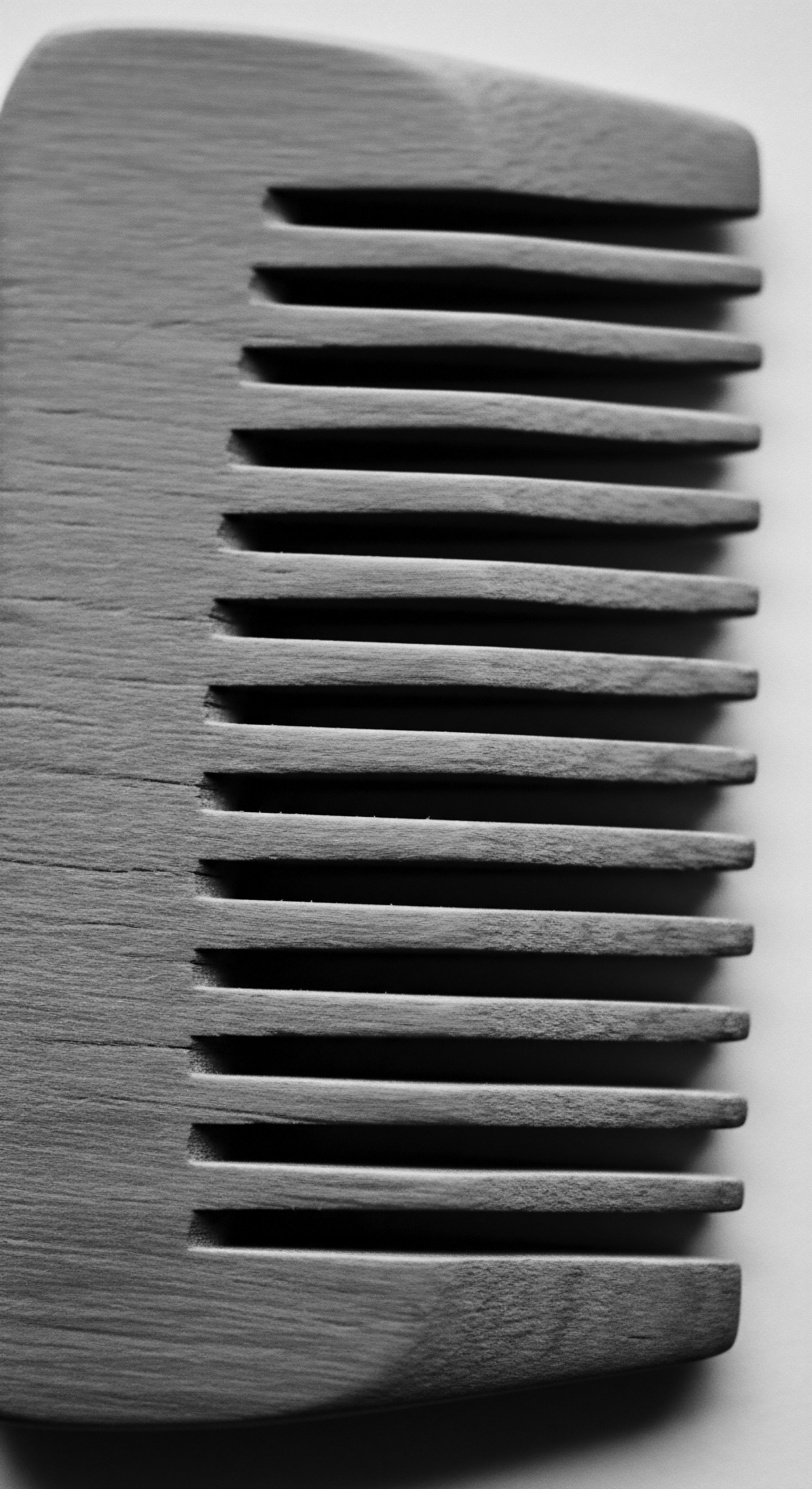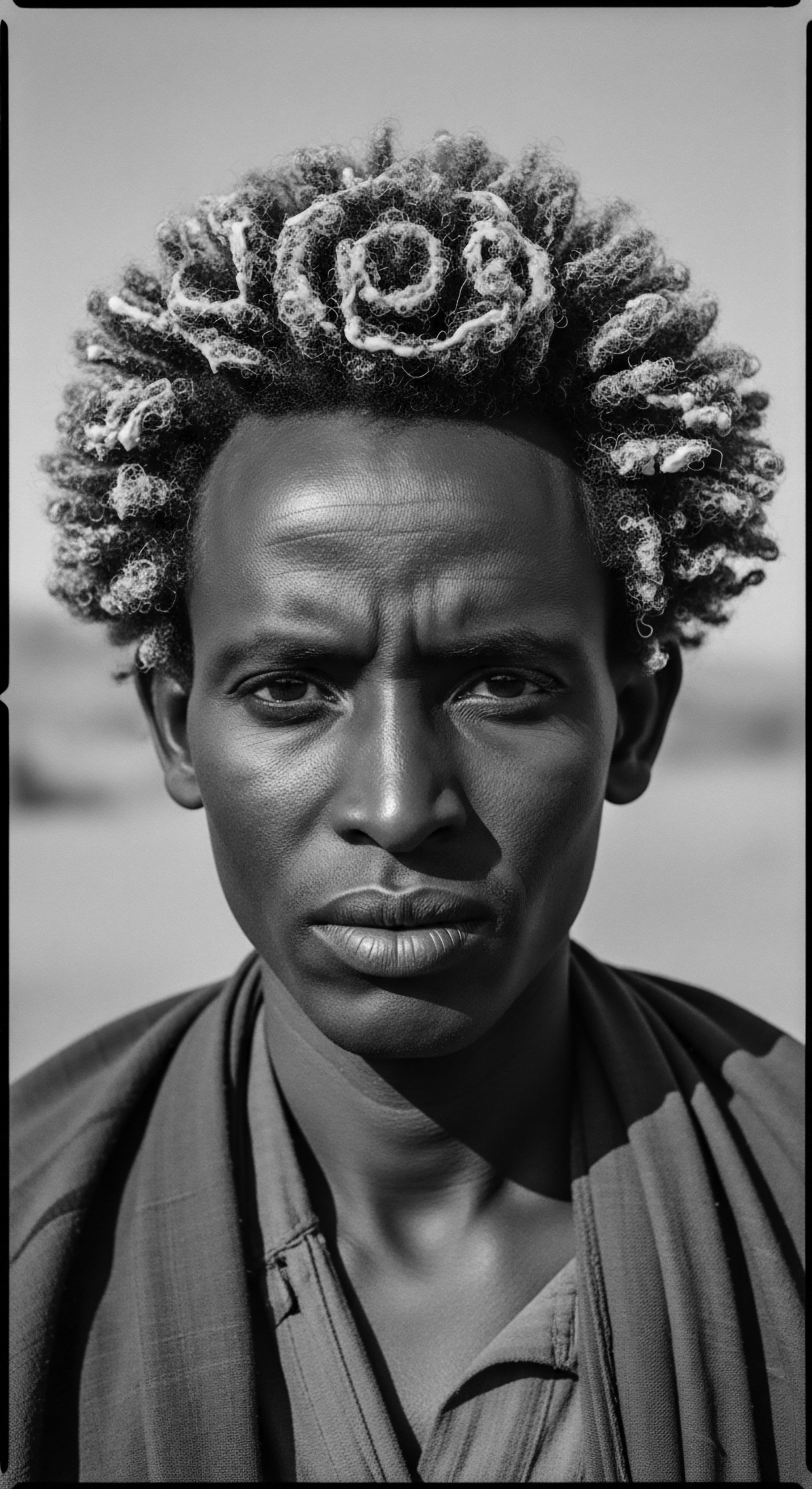
Fundamentals
From the deepest cellular whispers to the outward expressions of our crowning glory, the very notion of ‘Stress Hormones’ carries a significance that extends far beyond clinical definitions. For those whose lineage flows through the rich currents of textured hair heritage, this biological communication system holds layers of understanding, resonating with ancestral knowledge and the lived experiences of generations. We begin with a basic, foundational understanding of what these chemical messengers are, unraveling their initial meaning in the intricate machinery of the human form, yet always with an eye toward their deeper historical and cultural imprint on our hair.
At its elemental level, the body possesses an ancient, reflexive wisdom, a system of internal communication designed to respond to perceived challenges. This system, honed over eons, relies on the swift release of specific chemical compounds known simply as stress hormones. Think of them as urgent dispatches from the body’s internal command center, signaling a need for immediate adaptation.
When a perceived threat emerges, whether real or imagined, the body gears itself for action or withdrawal. This initial wave of hormonal response, while a marvel of physiological efficiency, also holds a particular resonance for those with textured hair, whose ancestral journeys often involved continuous adaptation to environments and circumstances far removed from tranquility.
Stress hormones are the body’s ancient chemical messengers, initiating a swift response to perceived challenges, a biological echo of resilience passed down through generations.

The Body’s First Response ❉ Adrenaline and Noradrenaline
The most immediate, widely recognized of these hormones are Adrenaline (epinephrine) and Noradrenaline (norepinephrine). Released from the adrenal glands, perched like watchful sentinels above the kidneys, these catecholamines flood the system in moments of acute alarm. Their purpose? To prime the body for what ancestral wisdom might term ‘fight or flight.’ Heart rate quickens, breathing deepens, and blood flow reroutes to essential muscles, sharpening senses.
For a person of African descent navigating historical periods of immense peril, this physiological readiness was not an abstract concept but a stark, everyday reality, woven into the very fabric of existence. The rapid surge might have meant the difference between survival and despair.
- Adrenaline ❉ Often called the ’emergency hormone,’ this compound rapidly readies the body, enhancing physical performance and sharpening mental focus, an instinctive response that has served humanity since time immemorial.
- Noradrenaline ❉ Closely allied with adrenaline, it primarily contributes to alertness and arousal, maintaining vigilance and readiness during moments of heightened tension.
Understanding the immediate impact of adrenaline and noradrenaline allows us to appreciate the body’s primal protective mechanisms. However, for those with textured hair, whose heritage often includes centuries of systemic stressors, the sustained, gentle hum of these hormones can shift into a persistent, unsettling vibration, impacting not only the spirit but the very strands that adorn the head. This initial understanding provides a necessary foundation for exploring the more enduring effects of chronic stress, a topic profoundly relevant to the story of textured hair.

Cortisol ❉ The Sustained Messenger
Beyond the immediate burst of adrenaline, another significant stress hormone emerges for the long haul ❉ Cortisol. Produced by the same adrenal glands, cortisol operates on a slower, more sustained timeline, a persistent presence in the body’s response to ongoing demands. Its role is multifaceted, influencing metabolism, immune function, and inflammation.
While essential for modulating the body’s reactions and restoring balance after an acute challenge, its prolonged elevation can exact a silent toll. For those of African and mixed heritage, historical and contemporary experiences of chronic social, economic, and systemic pressures have often meant sustained cortisol production, subtly altering internal landscapes.
The very concept of stress hormones, therefore, serves as an initial interpretation of how the body reacts to the world. It provides a biological delineation of the ‘fight or flight’ response, a fundamental statement of our shared human physiology. Yet, within the vibrant context of textured hair, this initial designation gains a unique resonance, hinting at deeper stories of resilience, adaptation, and the enduring connection between our internal states and the outward presentation of self. The significance of these hormones, even in this elementary exposition, begins to touch upon the profound bond between physiological response and the ancestral memory held within each strand.

Intermediate
As we delve deeper into the understanding of stress hormones, their meaning broadens, extending beyond a simple fight-or-flight response to encompass a more intricate interplay with our long-term wellbeing, especially as it touches upon the particularities of textured hair and its heritage. This intermediate exploration begins to bridge the chasm between immediate physiological reactions and the sustained, often generational, impact of chronic stressors. We consider how these chemical signals, initially designed for acute survival, can, when consistently activated, influence the very health and vibrancy of our hair, a connection profoundly felt within Black and mixed-race communities.
Intermediate insight reveals stress hormones not as mere emergency signals, but as long-term influencers, shaping hair health in ways deeply intertwined with ancestral experiences.

The Hypothalamic-Pituitary-Adrenal (HPA) Axis ❉ The Command Center
The release of stress hormones is not a random occurrence but a carefully orchestrated symphony involving several key players. At the heart of this system lies the Hypothalamic-Pituitary-Adrenal (HPA) Axis, a complex neuroendocrine pathway. Imagine it as the body’s intricate communication network, where the hypothalamus (a region in the brain) signals the pituitary gland, which in turn signals the adrenal glands to release cortisol. This feedback loop is designed for balance; once the threat subsides, the HPA axis should quiet down, returning the body to a state of equilibrium.
However, for communities whose historical reality involved continuous exposure to social, economic, and even physical threats, this delicate balance often tipped into a state of chronic activation. The ancestral memory of constant vigilance, of being ‘on edge,’ might have left an indelible mark on how this axis functions across generations, influencing sensitivity to stress.
The constant engagement of the HPA axis, when not tempered by periods of rest and recovery, can lead to what is known as Allostatic Load – the cumulative wear and tear on the body’s systems due to chronic stress. This concept is particularly salient for understanding the textured hair journey. For centuries, individuals of African descent, for instance, navigated landscapes laden with overt and subtle forms of oppression.
From the brutality of forced labor to the insidious pressure of Eurocentric beauty standards, the burden of adaptation was immense. This persistent allostatic load has not merely been a psychological experience; it has registered physiologically, potentially influencing cellular processes, inflammation, and even the hair follicle itself.

Impact on Hair Follicle and Scalp Health
The pathways through which stress hormones can influence hair are surprisingly direct and deeply understood by modern science, often validating traditional hair care practices. The hair follicle, a marvel of biological engineering, is not an isolated entity; it is richly supplied with blood vessels and nerve endings, and it possesses receptors for various hormones, including those associated with stress.
- Increased Inflammation ❉ Elevated cortisol levels can trigger systemic inflammation. For the scalp, this can manifest as irritation, itching, or even conditions like seborrheic dermatitis, disrupting the delicate environment necessary for robust hair growth. Ancestral practices often involved soothing scalp treatments, perhaps intuitively addressing this inflammatory response long before its biological underpinnings were known.
- Disruption of Hair Growth Cycle ❉ Hair growth proceeds in distinct phases ❉ Anagen (growth), Catagen (transition), and Telogen (resting). High or chronic stress can prematurely push hair follicles into the telogen phase, leading to increased shedding, a condition known as telogen effluvium. This sudden loss, often observed after periods of intense pressure, speaks to the intimate connection between our internal states and the outward appearance of our strands.
- Sebum Production Alterations ❉ Stress hormones can influence the activity of sebaceous glands on the scalp, leading to either excessive oiliness or dryness. This hormonal imbalance can create an environment less conducive to healthy hair, making textured hair, with its unique structural properties and moisture needs, particularly vulnerable. Traditional oiling rituals, passed down through generations, often sought to maintain this delicate scalp balance.
The meaning of ‘Stress Hormones’ at this intermediate level, then, becomes a deeper exploration of their systemic reach, their capacity to induce sustained physiological changes, and their specific relevance to the unique biology of textured hair. It compels us to consider how generations of living under conditions of chronic stress have not only shaped cultural practices around hair care but may have also left subtle, yet observable, imprints on the hair itself. This understanding allows us to appreciate the resilience required to maintain hair health and cultural expression in the face of relentless pressure, transforming a biological term into a narrative of historical endurance.

Academic
The academic understanding of ‘Stress Hormones’ transcends rudimentary definitions, delving into the complex neuroendocrinological pathways, the cellular intricacies of their action, and the profound, often intergenerational, implications for human health and identity. For textured hair communities, a scholarly examination of these biological agents necessitates a deeply contextualized lens, one that acknowledges the unique historical and ongoing burdens of systemic stressors that have shaped Black and mixed-race experiences globally. This exploration moves beyond mere physiological response to address the socio-cultural embedding of biological phenomena, particularly how chronic activation of stress pathways has profoundly influenced the health, care, and symbolic meaning of hair.
A scholarly lens reveals stress hormones as intricate biological mediators, their persistent activity in textured hair communities profoundly shaped by historical systemic stressors.

Academic Meaning ❉ Allostatic Load and Epigenetic Inheritance
At its core, an academic delineation of stress hormones centers on their role within the Neuroendocrine Stress Response System, primarily involving the HPA axis and the sympathetic-adrenomedullary (SAM) axis. The former orchestrates the delayed, sustained release of glucocorticoids, predominantly cortisol, while the latter mediates the rapid secretion of catecholamines, adrenaline and noradrenaline. The scientific meaning of these hormones lies not just in their individual functions but in their dynamic interplay and the systemic consequences of their dysregulation.
When the body’s adaptive responses to stress are continuously engaged, particularly due to socio-environmental factors, this leads to Allostatic Load, a term coined by McEwen and Stellar (1993) to describe the cumulative physiological cost of chronic stress. This concept is indispensable for understanding the health disparities, including those affecting hair and scalp, observed in historically marginalized populations.
For individuals whose ancestry traces back to chattel slavery, colonial subjugation, or enduring racial discrimination, the concept of allostatic load gains poignant depth. The chronic, unrelenting stressors of these historical periods – physical brutality, psychological terror, economic exploitation, and persistent dehumanization – would have placed an immense, sustained burden on the HPA and SAM axes across generations. This is where the academic definition intertwines with the notion of Epigenetic Inheritance. Emerging research suggests that prolonged exposure to severe stress can induce epigenetic modifications – changes in gene expression without altering the underlying DNA sequence – that can be passed down to offspring.
While direct causation linking historical stress hormones to contemporary hair characteristics is a frontier of research, the documented impact of maternal stress on fetal development and subsequent health trajectories offers a compelling theoretical framework for considering intergenerational effects. For instance, studies on the descendants of Holocaust survivors or individuals who experienced extreme famine have identified epigenetic changes related to stress response genes (Yehuda et al. 2016). This suggests that the profound stress experienced by ancestors enduring forced migrations and systemic oppression might have subtly altered the physiological ‘set point’ for stress reactivity in their progeny, potentially influencing various bodily systems, including those governing hair follicle function and hair health.

The Sociological and Biological Nexus ❉ Hair Policing and Textured Hair Health
One particularly illuminating case study that powerfully connects stress hormones, ancestral practices, and the lived experiences of textured hair communities is the phenomenon of ‘hair policing’ and its physiological consequences. Throughout history, and continuing into the present, Black and mixed-race individuals have faced immense pressure to conform to Eurocentric hair standards, often through the use of harsh chemical relaxers, excessive heat, or restrictive styling. This pressure is not merely aesthetic; it is deeply interwoven with issues of social acceptance, economic opportunity, and personal safety, thereby constituting a significant, chronic psychosocial stressor.
Consider the seminal work of Dr. Cheryl Townsend Gilkes on the sociology of Black women’s hair, or Dr. Regina Jackson’s historical accounts of hair in the Black community. While they may not directly measure cortisol levels, their narratives paint a vivid picture of the relentless social scrutiny and systemic discrimination faced by Black women based on their hair texture.
This constant external pressure to alter natural hair, often driven by fear of professional or social reprisal, translates into significant internal stress. A compelling study by Gaskins, Et Al. (2018) published in the Journal of Black Psychology, investigated the physiological impact of perceived racial discrimination on hair care practices among Black women. While not directly measuring stress hormones, their findings on increased psychological distress associated with hair-related discrimination provide a rigorous conceptual bridge.
The chronic apprehension of being judged, marginalized, or deemed “unprofessional” due to natural hair texture triggers a sustained activation of the HPA axis. This persistent internal stress, manifesting as elevated cortisol, has demonstrable effects on the integumentary system.
| Historical Context of Stress Enslavement & Post-Emancipation Conformity Pressures (e.g. "straight hair" as survival mechanism) |
| Physiological Manifestation (Stress Hormones) Sustained HPA axis activation, elevated cortisol, chronic allostatic load. |
| Observed Hair/Scalp Impact Increased scalp inflammation, altered sebaceous gland activity, potential for early hair shedding (telogen effluvium) due to systemic distress; exacerbated by harsh chemical treatments. |
| Historical Context of Stress 20th Century Desegregation & "Good Hair" Ideology (social/professional acceptance linked to hair straightening) |
| Physiological Manifestation (Stress Hormones) Chronic psychosocial stress, neuroendocrine dysregulation due to racial discrimination and aesthetic policing. |
| Observed Hair/Scalp Impact Stress-induced follicular miniaturization, compromised scalp barrier function, heightened sensitivity to external irritants, potentially contributing to conditions like central centrifugal cicatricial alopecia (CCCA) from repeated chemical/heat stress. |
| Historical Context of Stress Contemporary Hair Discrimination (e.g. CROWN Act necessity in workplaces/schools) |
| Physiological Manifestation (Stress Hormones) Ongoing psychological distress, sustained HPA axis activation, impact on sympathetic nervous system tone. |
| Observed Hair/Scalp Impact Increased hair shedding, changes in hair texture or growth patterns, compromised immune responses in the scalp, potentially leading to aggravated inflammatory scalp conditions. |
| Historical Context of Stress The enduring legacy of systemic stressors on textured hair communities is physiologically registered through stress hormone pathways, highlighting the deep connection between social justice and hair health. |
The chronic stress induced by societal pressure to conform to Eurocentric beauty standards can lead to a state of persistent inflammation and oxidative stress within the scalp microenvironment. The hair follicle, being one of the most metabolically active tissues, is highly susceptible to these internal shifts. Elevated cortisol levels can directly inhibit the growth of dermal papilla cells, crucial for hair follicle regeneration, and can also increase the production of pro-inflammatory cytokines, creating a hostile environment for hair growth. Furthermore, the sustained activation of the sympathetic nervous system, mediated by noradrenaline, can lead to vasoconstriction of blood vessels supplying the hair follicles, reducing nutrient and oxygen delivery.
This complex interplay of hormonal signals, inflammation, and reduced blood flow contributes to hair thinning, breakage, and the exacerbation of various scalp conditions commonly observed in textured hair. The academic investigation of stress hormones, therefore, extends beyond the laboratory to encompass the profound socio-historical context in which hair identity has been forged and sometimes fractured.
The profound academic meaning of ‘Stress Hormones’ for textured hair communities is thus multi-layered. It describes the physiological mechanisms of stress response, identifies the pervasive nature of allostatic load stemming from historical and contemporary discrimination, and posits the potential for epigenetic inheritance of stress susceptibility. It illuminates how external societal pressures translate into internal biological realities, shaping not only the health of our hair but also the enduring cultural practices developed to nurture and protect it against a backdrop of continuous challenge. This scholarly lens validates the ancestral wisdom embedded in traditional hair care, recognizing that community, care, and self-acceptance are not just spiritual balms but potent physiological counter-measures against the insidious impact of chronic stress.

Reflection on the Heritage of Stress Hormones
To contemplate stress hormones within the narrative of textured hair is to engage in a profound meditation on resilience, on the soul of a strand. Our journey through their elemental biology, intermediate workings, and academic complexities culminates in a deeper understanding of their enduring heritage and evolving significance. It is a recognition that the whispers of ancestral wisdom, often dismissed as folklore, held profound insights into the body’s responses to the world, insights that modern science now echoes with compelling precision.
From the communal scalp massages practiced under the ancient baobab trees, acts of tender care that surely modulated the very hormones of stress, to the meticulous braiding rituals that offered moments of solace amidst relentless pressure, Black and mixed-race communities have always understood the inextricable link between inner peace and outer flourish. Our ancestors, lacking scientific instruments to measure cortisol, nonetheless discerned the toll of turmoil on the body and spirit, prescribing remedies of connection, ritual, and botanicals – actions that, we now know, directly counter the physiological impacts of prolonged stress. They understood that the care of the hair was not merely aesthetic; it was an act of profound self-preservation, a shield against the pervasive currents of adversity, a defiant statement of being.
The journey of stress hormones through the heritage of textured hair reveals an unbreakable bond between ancestral wisdom, personal well-being, and collective resilience.
The textured helix, with its unique architectural strength and delicate nature, stands as a living archive. It bears the invisible imprints of joy, sorrow, struggle, and triumph, a testament to the cumulative experiences of a people. When we speak of stress hormones in this context, we are not just discussing chemical compounds; we are speaking of the biological narrative of survival, of adaptation, of the sheer fortitude required to maintain cultural identity and personal dignity in the face of systemic challenges.
The understanding of these hormones becomes a tool not of fear, but of empowerment, allowing us to validate ancestral care practices, to contextualize hair health disparities, and to champion self-acceptance as a revolutionary act. The reflection on stress hormones, therefore, serves as an invitation ❉ to listen more closely to the wisdom embedded in our hair, to honor the enduring legacy of care, and to nurture our textured strands as vibrant extensions of our ancestral lineage, unbound and ever-present.

References
- Gilkes, C. T. (1998). “If It Wasn’t for the Women. ” ❉ Black Women’s Experience and Womanist Culture in Church and Community. Orbis Books.
- Gaskins, P. B. et al. (2018). The Impact of Racial Discrimination and Hair Bias on the Psychological Well-Being and Hair Care Practices of Black Women. Journal of Black Psychology, 44(3), 209-231.
- Jackson, R. L. (2009). The Hair Story ❉ Untangling the Roots of Black Hair in America. St. Martin’s Press.
- McEwen, B. S. & Stellar, E. (1993). Stress and the Individual ❉ Mechanisms Leading to Disease. Archives of Internal Medicine, 153(18), 2093-2101.
- Saplosky, R. M. (2004). Why Zebras Don’t Get Ulcers ❉ The Acclaimed Guide to Stress, Stress-Related Diseases, and Coping. Holt Paperbacks.
- Yehuda, R. et al. (2016). Parental Posttraumatic Stress Disorder and Offspring Genes ❉ The Case of the Holocaust. Biological Psychiatry, 80(3), 200-205.
